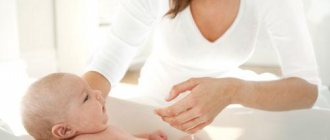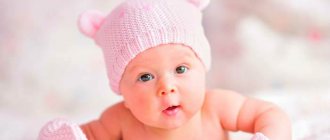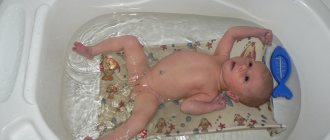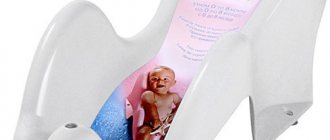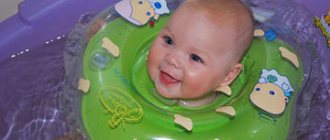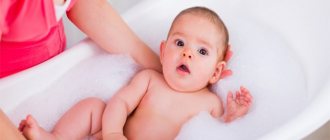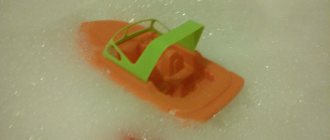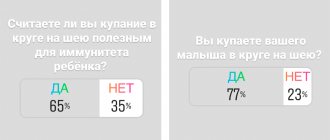After returning from the maternity hospital, mother and baby get acquainted with the new order of life. The first bath of a child is especially exciting, because there is so much to consider: heat the water to the desired temperature, choose foam, properly arrange the baby in the bath. Let's look at the most common questions of young parents about how to bathe a newborn baby, in what water and how often the baby should be bathed so that the procedure is calm for mom and dad and pleasant for the baby every time.
Even during pregnancy, parents should prepare the bathroom. There should be:
Own bathtub for bathing newborns
Plastic slide or hammock for swimming in the tub
Small mug or ladle for rinsing
A thermometer to check if the water is warm enough
Soft, clean towels or diapers
Soaps, foams and shampoos for bathing
Preparation for the process
Necessary equipment for bathing a newborn:
- Bath. Up to 3 months, it is recommended to bathe your baby in a baby bath. Before each use, it must be thoroughly washed with soda and doused with boiling water. The recommended length of the bath is 65 cm.
- Hammock or slide. The mother will need them if she washes the baby without helpers.
- Water thermometer. Necessary for measuring water temperature.
- Cleanser. The baby should be washed with baby wash (soap, foam, gel) no more than 1-2 times a week without using a washcloth. A washcloth can damage delicate baby skin.
- Shampoo. You can use baby shampoo 2 times a week. The rest of the time, the head is simply washed with water. Instead of shampoo, you can use foam to wash your body and hair. The label of the product should indicate “from crown to toe.”
- Diaper. In the first month of life, the baby is bathed wrapped in a thin diaper. This is done in order to protect the fragile body from the difference in air and water temperatures.
- Towel. For your baby you need to buy your own soft, large towel.
- A jug of warm boiled water to rinse your baby after bathing.
A real bath in the bath
When the umbilical wound has completely healed, your child is ready for real water procedures in a baby bath or in a special bathing container. Before giving your newborn his first bath at home, place a towel in the bottom of the bathtub to make it softer. If you do not have experience, then ask your husband or new grandmother (your mother) to help. Prepare everything you need in advance so that you don’t have to run around or look for it while swimming.
Here is a simple list of what you will need to give your newborn a first bath at home:
- Baby towel with hood;
- Soft cleaning cloth or sponge;
- Cotton pads;
- Special soap for children or bathing liquid;
- A soft baby brush or comb.
To effectively bathe your baby, you only need about 5 cm of warm water.
A newborn's first bath at home doesn't have to be long or complicated, but it should be productive. Hold your baby confidently and wash him/her gently, removing dirt that has accumulated from the skin. When bathing, you must secure his head and back. When you bathe your baby, pay attention to:
- The genital areas and places where diapers are attached;
- Hands and feet. Also check the spaces between the phalanges of the fingers and toes;
- Folds of skin under the knee, on the neck and thighs;
- Face. If you find any foreign particles in the eye area, remove them with a cotton pad;
- Armpits – unnecessary germs accumulate in these places;
- Behind the ears.
What water to swim in
Wash the newborn in boiled water, cooled to the desired temperature, until the umbilical wound is completely healed. To disinfect water, you can add a solution of potassium permanganate. Dissolve a pinch of potassium permanganate in a glass of boiling water and mix thoroughly. The solution should be light purple. After adding it to the bath, the water will turn pale pink.
Newborn bathing procedure
The child must be carefully immersed in water, starting from the feet. The head should be above the water. Make sure that water does not get into the ears.
If the mother bathes the baby herself, you need to place one hand under the baby’s head and grab him by the armpit. Above the wrist is the baby's head. The baby is held under the bottom with the other hand. After lowering the baby into the water, you can release the other hand.
The child is washed from the neck to the legs. The hair is washed at the very end. The baby should be washed gently by hand or with a cotton swab. Do not rub the skin - this can damage the delicate skin. Wash your face with clean water from a rinse bucket.
Bathing lasts 5-10 minutes. Gradually the period can be increased to 30-40 minutes. When bathing for a long time, you need to add hot water. You can simply add water to the bath using a tea cup, along the edge, so as not to splash the baby. At the end of bathing, the child is rinsed with clean water and immediately wrapped in a diaper. The most important thing is that the water procedure brings pleasure to all participants!
How to bathe a child, watch the video:
19 Oct 2014 Yuki 573
Share this post
We recommend reading along with this article
- Rules for caring for a newborn, carrying out the necessary…
- Feeding, sleeping, staying awake in the mode of a 2 month old baby
- How to bathe a newborn baby correctly: basic rules
- How to properly care for a newborn baby, what should...
- How to teach a child to eat independently: principles and recommendations
- All about childhood vaccinations: Should a child be vaccinated?
- How to make a children's room with a unique and inimitable design
- What a 4 month old baby can do - description...
- Is it worth having a second child: arguments for and against
Discussion: 3 comments
- MAMATUT:
07/13/2015 at 14:03I can recommend Chicco hair and body shampoo, it is very convenient, it is 2 in 1, even 3 in 1. You can use it as a shampoo, as a shower gel, we also use it as a bubble bath, then bathing becomes even more fun and playful. We really like it in all variations! The shampoo is tear-free, so you don’t have to worry about your eyes stinging or turning red, she’s very gentle with them. Hypoallergenic, you can safely use it from birth. The extract included in its composition helps to moisturize and soften delicate skin, and it also has protective and soothing properties. I also like the dispenser; it’s rare to find shampoos with such a convenient spout. It’s easy and simple to dose the norm, you don’t have to worry about overdosing. The formula is thick, making it economical to use. The smell is very pleasant, not at all intrusive, even barely perceptible, it foams just fine, and is easily washed off. We recommend it to everyone!
Answer
- Mila:
10/31/2016 at 00:21
We started bathing our baby a week after being discharged from the hospital. Our child simply loved to swim, in warm water with a decoction of the string, in order to avoid rashes on the body. Now our baby is already three years old and water is our element!))
Answer
- Elvira:
11.11.2017 at 18:41
We have long fallen in love with Chicco body and hair shampoo. It has earned our trust with its composition. It does not contain sodium lauryl sulfate. It is hypoallergenic and suitable for use already in the first year of life. The composition includes oat extracts; this soft component is useful for any skin type, and especially sensitive, allergy-prone skin. This shampoo foams well, has a pleasant light smell and a fairly thick consistency, and most importantly, does not sting your eyes.
Answer
Adding medicinal herbs to the bath
The use of chamomile, string, motherwort, and valerian is best discussed with your pediatrician. If a child is prone to allergies, atopic dermatitis and diaper rash are observed, then you should not use herbs. Also, they cannot be used until the navel is completely healed.
Adding medicinal plants to the bath is useful, but everything should be in moderation. You cannot prepare herbal baths every day, and it is also important to follow the dosage.
How to prepare a herbal decoction
- pour 3-4 tablespoons of dried herbs with 1 liter of boiling water;
- cover with a lid, leave to infuse for 1 hour;
- Before adding to water, strain through a sieve or cheesecloth.
What should the temperature be?
For parents who are preparing for their baby's first bath, it is important to adjust not only the water temperature, but also the air temperature in the room. It is optimal to warm the room to 24-26 degrees before bathing the newborn for the first time. The easiest way is to turn on the hot water for a few minutes. It is important to maintain this ratio of water and air temperatures to protect your baby from colds. Before bathing, it is also worth checking all windows and doors to ensure that there are no drafts in the rooms where the child will be brought in. Then you need to prepare a bath with warm water, about 37 degrees. Why do doctors advise sticking to this particular water temperature? It is as close as possible to the temperature of the mother’s amniotic fluid, so the newborn will feel comfortable. Old-school doctors still recommend washing a newborn baby only in boiled water. Whether you take old-fashioned advice is up to you.
What is the best way to check whether the water is warm enough or should I add more boiling water?
The most reliable way is to monitor the water temperature with a special thermometer. It is useful to acquire such a device for the future if you are going to practice home hardening, which many doctors consider useful (do not forget to consult with a specialist before you start radically experimenting with water temperature). You can also use the “elbow method” to check if the water temperature is suitable for bathing your baby. For an older baby, you can buy a toy thermometer with which the baby will splash.
It may turn out that your baby likes cooler water or, on the contrary, prefers a warm bath. Over time, try changing the temperature by 1-2 degrees to see how your child likes it better. If the baby starts crying, stop bathing and check if the temperature is abnormal. If the water is too hot, your baby's skin will quickly turn red. And if the water temperature is below normal, he will reflexively clench his fists and his skin will turn pale.
Antiseptic herbs
We recommend reading: Bathing in a line of newborns
A series. The best choice. Due to its high manganese content, it has a good anti-inflammatory effect. It copes with diaper rash, sweat rashes and dermatitis. However, it is not recommended to use it often, since the series dries out the skin greatly.
Chamomile and Calendula. The active ingredient in chamomile, chamazulene, relieves inflammation and soothes irritated skin. Baths with chamomile are especially useful for newborn girls as a prevention of gynecological ailments. Calendula also has similar effects, which in addition moisturizes and tones children's skin. It is an excellent antispasmodic, so baths with calendula are especially good during colic.
Bay leaf. The well-known bay leaf contains many microelements, vitamins and essential oils. It is an excellent antiseptic that helps with allergies and fungal diseases. For children's bathing in bay leaves, the following proportions are observed: 50 grams of dry bay leaf per liter of boiling water. It is infused for 8-10 hours, after which it is filtered and added to the bath.
Celandine. First of all, it is important to remember that celandine is a poisonous plant, so you should not get carried away with it. Newborns can be bathed in celandine to treat skin diseases, but only after consultation with the doctor.
Serena and calendula are good choices.
Pine extract. Acts as an immunostimulant. Relieves fatigue, has a beneficial effect on the respiratory and cardiovascular systems, as well as on the skin. Sold in pharmacies in concentrated form.
Herbs: which ones to choose?
Bathing in herbs is not at all necessary, but there are times when it becomes useful and even necessary. In most situations, a child begins to bathe in herbs for two reasons:
- Relieve irritation from baby skin. This is due to diaper rash that often occurs at this age.
- Have a beneficial effect on the nervous system. It happens that children are overexcited and suffer from intestinal colic, especially at night. Then calming herbs help relieve tension.
Let's consider which herbs are most often used for bathing a newborn and find out their properties.
Potassium permanganate: pros and cons
Bathing children in potassium permanganate is very common in the post-Soviet space. What is it used for and does it make sense to do so? Potassium permanganate (the official name of potassium permanganate) is added to water in the first weeks of a baby’s life for the purpose of disinfection, since manganese has high antiseptic properties.
The paradox is that a strong concentration of potassium permanganate solution, which has bactericidal properties, is dangerous for the life of a child. And the weak, pale pink liquid that is used to bathe newborns does not have the proper disinfecting effect. On the contrary, potassium permanganate can cause burns to the eyes or skin (if not diluted correctly).
Approximate amount of potassium permanganate to obtain 150 liters of pink solution
It turns out that children are bathed in potassium permanganate only to reassure their parents. If you nevertheless decide to use potassium permanganate, it is important to read the instructions for diluting it.
Necessary things
Prepare the following things:
- a large terry towel that has never been used before
- sterile cotton wool
- saline
- anti-slip bath mat
- cotton diaper
- cotton cloth for wiping
- cosmetics for newborns (at the request of parents)
- pouring cup
- clean diaper and clothes
- soft hair brush
When can you bathe a newborn after the hospital?
The best option would be to ask your pediatrician before leaving the hospital when you can bathe your baby. But if for some reason you haven’t figured this out, then to make a decision you need to take into account the presence or absence of a clothespin on the navel. How to treat a newborn's navel
In the maternity hospital, the umbilical cord is clamped with a plastic clothespin to speed up drying and healing. Such a clothespin falls off at different times, for some babies on the fourth day, for others on the tenth day. And until the clothespin falls off, it is not recommended to wet the navel. But you can safely wash your baby and dry him with a damp, warm cloth or napkins. As soon as the clothespin comes off, the baby can be bathed by immersion in the bath.
Important! If the clothespin falls off, but the umbilical wound has not dried (it is red, bleeding or festering), bathing should be postponed and a doctor should be called.
conclusions
A child's first bath is one of the most pleasant and wonderful moments for parents. If you are a first-time mother and are worried about bathing your newborn, we are sure that you will find many useful tips on our website. Choose the right moment when both you and your baby are relaxed, this first experience is sure to be special and will be remembered for a long time. Try to convey peace and happiness to your baby. If you are nervous, you can ask someone to join you and help you bathe your baby.
Infant swimming is becoming more and more popular, read here about when you can teach your child such activities.
Lots of doubts
It's normal for new moms to have a lot of questions about caring for their tiny newborn and their first time in the bathroom.
Some of the most common questions revolve around how to hold your baby to prevent him from slipping or falling. Mothers are also often unsure when is the right time to bathe their babies for the first time. And, of course, there are many doubts regarding how to get the desired water temperature.
Although you may have a little fear and anxiety about your little one's first bath, it will undoubtedly be an unforgettable experience.
Bathing your baby is a great opportunity to interact with your baby, with love and safety. That's why learning the rules of behavior is worth it.
Calming herbs
Designed to make the child's sleep pleasant, relieve tension, and also calm hyperactive children. Calming herbs include: valerian, motherwort, hop cones, lavender, juniper.
Having decided which herbs you will bathe your baby in, it is important to remember that you need to start not with mixtures, but with one-component formulations, since individual intolerance to any herb can manifest itself in the form of allergic reactions. Herbal baths are indicated for use only after the umbilical wound has healed.
Baths with lavender help you fall asleep faster
Contraindications
Despite the fact that water procedures are a necessary and pleasant ritual of caring for a baby, there are a number of contraindications for bathing:
- Pustular lesions of the skin.
- Acute illnesses with high fever.
- Unsatisfactory condition of the umbilical wound.
- On the day of vaccination, and two subsequent days after it.
A pediatrician's recommendation for bathing children with heart defects and other acute pathologies requires a special approach.
Optimal temperature for swimming
To make your child feel comfortable, the temperature of the water is important. For healthy children, the optimal temperature is 35-38 degrees, for premature and weakened children - 38 degrees. Over time, the water temperature can be reduced little by little, observing the baby's reaction.
Choose the right bathing water temperature!
It is convenient to use a special water thermometer. It does not contain mercury and quickly displays the water temperature. You can, of course, check the temperature the old fashioned way with your elbow, but a thermometer will still give more accurate readings.
Monitor your child's condition while bathing. If the baby is shaking, it means he is cold, and if his skin is red, the water is too hot.
